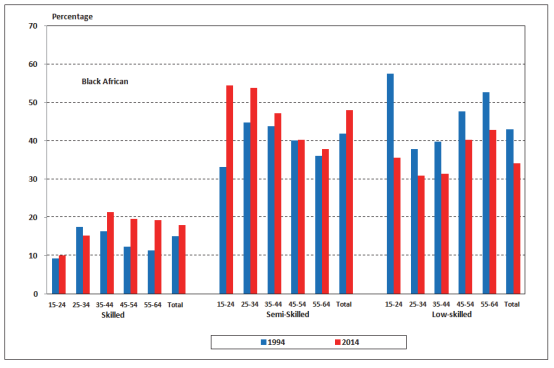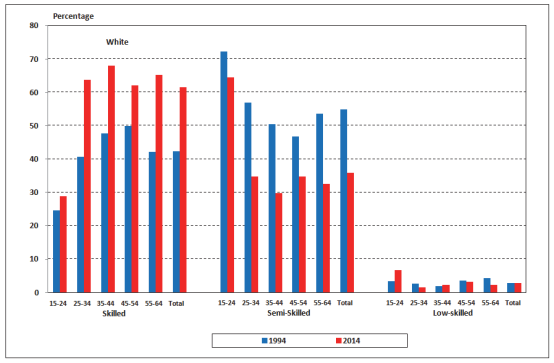The South African workforce shifts towards skilled jobs, but patterns still differ between race groups
There has been a shift in the last twenty years from low-skilled to semi-skilled and skilled work within the South African workforce. This was one of the results presented by the Statistician-General Pali Lehohla on the 15th September at a media event on youth unemployment.
Comparisons of data from the 1994 October Household Survey and the 2014 Quarterly Labour Force Survey show that in the first quarter of 2014, 25% of South African workers occupied skilled occupations (i.e. managers, professionals and technicians), an increase from 21% in 1994. However, a higher percentage (46%) were still in semi-skilled occupations (e.g., clerks, craft and related trades, and machine operators) in 2014, a slight decrease from 47% in 1994; and 29% were in low-skilled occupations (elementary jobs and domestic work), down from 32% in 1994.
Although the proportion of skilled workers within all race groups increased over the twenty-year period, the extent of change differs between the races. There were substantial shifts towards skilled work among white and Indian/Asian populations, with the proportion of skilled workers increasing from 42% in 1994 to 61% in 2014 among the white workforce (a gain of 19 percentage points), and an increase among the Indian/Asian workforce from 25% to 51% over the same period (a gain of 26 percentage points). The proportion of semi-skilled workers within the white workforce decreased from 55% in 1994 to 36% in 2014. Only 3% of white workers occupied low-skilled occupations in both 1994 and 2014.
An examination of the data also revealed little movement towards skilled employment among the black African workforce, with the black African workforce showing only a slight movement towards skilled occupations, but a more substantial movement towards semi-skilled occupations. In 1994, 15% of black African workers occupied skilled jobs, increasing to only 18% in 2014.
Over the same period the proportion of black African workers in semi-skilled occupations increased from 42% to 48%. It is also worth mentioning that the black African workforce's decrease of 9 percentage points for low-skilled occupations (43% to 34%) contributed to the general shift towards skilled occupations.
When the same analysis is applied to age groups, the data show that there has been a shift towards skilled work in all age groups within the four population groups, with the exception of black Africans aged 25-34 years. In 1994, 17% of black African youths aged 25-34 occupied skilled occupations. In 2014, this decreased to 15%. Addressing effective skills development will be a crucial dimension in reducing the country's high rate of unemployment.
Graphs from the report:
Employment composition within each skills level of the black African population group, by age group
Employment composition within each skills level of the white population group, by age group
Download the presentation here - PDF
Download the full report here - PDF
Statement issued by StatsSA, September 15 2014
Click here to sign up to receive our free daily headline email newsletter



